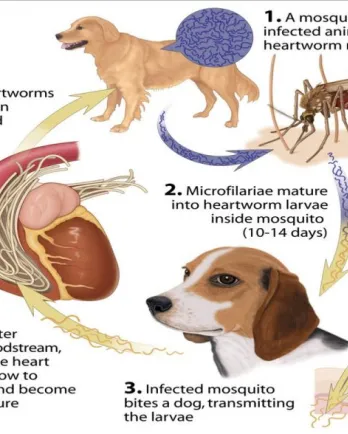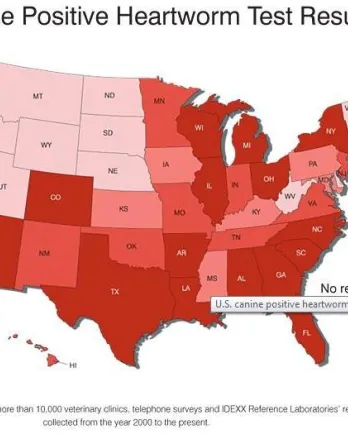Annie’s Saga: Heartworm Disease By Denise Fleck, The Pet Safety Crusader™
Affectionate, gentle, energetic and built for long days in the field. Vizslas are known to be an athletic breed - eager and graceful trotters possessing great stamina and making them ideal jogging or biking companions.
Picture Annie: a Heartworm positive two-year-old Vizsla who is currently on restricted activity during treatment. Annie arrived at the Animal Protective Foundation in Glenville, New York, last November and was lucky to be fostered by a family who had every intention of adopting her, but…it turned out to not be the right fit. When a door closes, often another opens and this allowed Annie’s next foster, and now forever mom, Emily Couper, to step in. Emily had prior Vizsla experience which was a plus for she understood what treatment would be like for a dog built to be on the go. APF’s protocol for heartworm patients, like most veterinarians, includes gentle on-leash walks and no running, jumping or playing off-leash. The risk of dying worms getting lodged in arteries and blood vessels increases with boisterous behavior. According to Sheila Leguire APF’s Animal Care & Welfare Manager, “Inside the home, we request that dogs undergoing treatment be crated as much as possible to reinforce the need for a calm, low-key lifestyle until they are worm-free.”
Heartworm disease can be life-threatening and is spread by infected mosquitoes. Occurrence of the disease in shelter dogs is higher than in the family pet as strays are less likely to have received prior veterinary care or to have been on heartworm preventive. Additionally, our volatile planet and its natural disasters have displaced pets from hurricane-ravaged areas to other parts of the country. More families now include Fido on vacations while some people and their pets, tired of the hustle and bustle are camping or living in areas closer to wildlife. All of these changing scenarios are permitting infections to occur in places where they had been previously unseen.
What exactly is Heartworm Disease?
Foot long, spaghetti-like worms that choose big dogs, little dogs, puppies, adults and seniors, cats and also ferrets as their hosts. More than one million animals are infected each year by these parasites. Heartworm disease can affect other mammals as well (wolves, coyotes, foxes, sea lions and rare but possible…humans!), but dogs are natural hosts meaning that heartworms live inside the dog, mature into adults, mate and produce offspring. Untreated, their numbers can multiply into the hundreds! The worms live in the heart, lungs and blood vessels and can potentially affect many vital organs. Outcome of infection varies greatly from patient to patient but adult worms cause inflammation of the blood vessels and can block blood flow leading to pulmonary thrombosis (clots in the lungs) and heart failure. Other animals may live for a long time with only a few adult heartworms and show no clinical signs unless faced with an environmental change, such as an extreme increase in temperature, or another significant health problem.
Signs & Symptoms of Heartworm Disease in Dogs
- Coughing
- Exercise intolerance
- Weight loss
- Tachypnea (abnormal rapid breathing)
- Ascites (abnormal accumulation of fluid in the abdomen)
Heartworm Disease though, is a different beast in cats, since felines are atypical hosts meaning most heartworms do not survive to the adult stage. A cat with heartworms typically has one to three worms and is often undiagnosed. It is important to note however, that even immature worms can harm in the form of Heartworm Associated Respiratory Disease (HARD). Signs may include: coughing, asthma-like attacks, vomiting, loss of appetite or weight loss. Less common, affected cats may have difficulty walking, faint, convulse or experience fainting or seizures or fluid accumulation in the abdomen.
How is Heartworm Disease Transmitted?
That pesky mosquito! Adult female heartworms live in infected dogs, foxes, coyotes or wolves for instance, and produce microfilaria. These baby worms circulate in the bloodstream and are sucked up in a blood meal when a mosquito bites an infected animal. They develop into larvae over the next 10 to 14 days, and when this doggone infected mosquito then bites your dog, the larvae enter Rover through the mosquito’s bite wound. Once inside, the larvae take 6 months to mature into adult heartworms and then can live and breed for 5 to 7 years in dogs and up to 2 or 3 years in cats.
An Ounce of Prevention…
According to the American Heartworm Society, Heartworm Disease is inexpensive and easy to prevent but costly and difficult to treat. Preventives come in the form of once-a-month chewable tablets, a once-a-month topical application and twice-a-year injections. They work by eliminating the immature (larval) stage of the parasite but cannot effectively destroy the adult worm, so…it’s important to stay on schedule with preventive medications!
The U.S. Food and Drug Administration (FDA) requires that heartworm preventives must be purchased from your veterinarian or with a prescription through a pet pharmacy. Prior to prescribing a heartworm preventive, your veterinarian will perform a heartworm test to make sure your dog does not already have adult heartworms. Although rare, giving preventive to a dog with adult heartworms could be harmful. Young puppies or kittens however, are not typically tested as it takes 6 months for heartworms to develop to adulthood.
Back in Upstate New York, the Animal Protective Foundation had never before treated heartworm in their shelter. Explains Leguire, “We organized our plan to ensure the most effective outcome and then went in search of a foster or forever home so that treatment could begin. The shelter is NOT an ideal place at all to treat for this disease. It’s very high-stress in kennels and the environment in and of itself is not conducive to a successful treatment of the disease.”
Heartworms do not discriminate! Puppies, adults and senior dogs are equally susceptible. The American Heartworm Society recommends that puppies be started on a heartworm preventive as early as the product label allows, and no later than 8 weeks of age. Dosing is based on body weight, not age, so a rapidly growing pooch may gain enough weight to bump it from one dosage range to the next within a matter of weeks. Always talk to your veterinarian for advice about changing your dog’s dosage!
A Heartworm Vaccine does not currently exist, yet researchers continue to look into the possibility.
Where does Heartworm Disease Occur?
Heartworms have been found in all 50 states. High-risk areas include large portions of the United States (i.e. Atlantic and Gulf coasts and along river tributaries) however, most states have "hot spots" where heartworm infection rate is substantially higher than in other parts of the region. Circumstances influencing the risk of heartworm infection include climate (wet and warm), species of mosquito and proximity to breeding areas as well as other infected animals (coyotes and foxes, for example). Even those to the more frigid north aren’t out of the woods. It’s a survival of the fittest world, and even mosquitoes change and adapt to cold climates. No mosquito hotels thankfully, but some species do successfully winter indoors!
Los Angeles Vector Control recently announced that a mosquito species from Australia was found in Southern California. The species, Aedes notoscriptus, also known as the "Aussie Mozzie,” was previously undocumented in the U.S. Don’t think you pet is safe just because pets have been safe in your neck of the woods in decades passed.
Best Practices for Your Travelling Dog
Not only are shelters transporting dogs after disasters to provide a better chance of finding a forever home, but Fido is on the go with his humans more than ever before – a whopping 50% of pets now go on family vacations, often travelling from areas of low heartworm incidence to regions where disease may be more prevalent.
Best practices for rescue workers, veterinarians, handlers and dog moms and dads include:
1. Testing all dogs over 6 months of age for microfilariae (microscopic baby heartworms noted as Mf) and heartworm antigen (Ag) prior to travel. If for some reason, testing is not possible, assume the pet may be infected and proceed to Step 3b below.
2. If a dog tests positive for microfilariae or antigen, postpone travel and begin treatment in accordance with the American Heartworm Society (AHS) Guidelines. Keep in mind that dogs with clinical signs attributed to heartworm infection should not be transported and that dogs that have begun treatment need a calm, stress-free environment so should not be transported for at least 4 weeks after an injection.
3. If a dog tests positive and travel truly cannot be postponed, a clinical decision must be made based on the dog’s heartworm status and health:
a. If the dog is Mf-/Ag+, administration of an approved macrocyclic lactone product or a 4-week course of doxycycline fit current protocol and should prevent dog from become microfilaria positive. Testing can be repeated in 7 days and if negative, proceed with relocation.
b. If Mf+/Ag- or Mf+/Ag+, apply an approved moxidectin topical product and proceed with relocation. A single dose of topical moxidectin prior to transport will eliminate most microfilariae. An alternative is to administer an approved macrocyclic lactone product along with a topical canine insecticide (containing permethrin + dinotefuran + pyriproxyfen) that is labelled to kill and repel mosquitoes. This will prevent infection of mosquitoes and subsequent transmission of infective larvae during transportation and for 1 month thereafter. Another alternative, administer a 4-week course of doxycycline which will render microfilariae incapable of normal development.
Once a heartworm-positive dog has been safely transported, heartworm treatment should be completed according to AHS Guidelines as soon as possible.
4. If dogs test negative for microfilariae and antigen, proceed with travel and administer macrocyclic lactone preventive drugs to dogs greater than 6 weeks of age. Repeat microfilariae and antigen testing in 6 months. Thereafter, if history of preventive administration is well-documented, repeat testing every 12 months.
Caring for dogs that are on-the-go can be a challenge, so due diligence is a responsibility that must be met by all canine caregivers to mitigate heartworm transmission.
Treatment
Treatment occurs over several months to eliminate all the larvae and adult heartworms from your dog’s body. Obviously, the pet’s overall health must be considered before treatment begins as this is an arduous task. The initial stage focuses on killing the adult worms via a series of Immiticide injections. Annie the Vizsla received 3 over a 4-month time span. Once treated, the heartworms die slowly and begin to dissolve, taking several weeks. Three to four weeks later, your dog will begin phase two to get rid of the baby heartworms. Following that, continued checkups and testing continues, and your canine pal will be placed on heartworm preventative medication. “Heartworm disease is a complex disease, and there are no shortcuts to appropriate treatment,” says Chris Rehm, DVM and President of the American Heartworm Society. AHS protocol was designed to kill adult worm infections with minimal complications while stopping the progression of disease. “Skipping any one of these steps can affect both the safety and efficacy of heartworm treatment,” he concludes.
Unfortunately, no approved drug therapy for heartworm infection in cats exists, and the drug used to treat dogs is not safe for our feline companions. Nevertheless, cats with heartworm disease can be stabilized with good veterinary care.
What Can You & Your Dog Expect During Heartworm Treatment
After initially treatment begins, it is essential that your pooch is confined with limited activity levels for four weeks. Excessive activity and exercise can increase the risk of movement of the dead heartworms through the body, clogging arteries and creating serious heart/lung complications. You may expect your dog to be:
Low energy. Actually sleepy for several days which can work to your advantage since you want to keep him quiet during his convalescence.
Soreness at the injection site.
Followed by increased energy, but it is imperative that you keep him calm and refrain from exercise for that first month. How? I’m glad you asked…
- Chew toys, food-stuffed toys and doggie puzzles may occupy your dog’s mind and keep his brain active and his body still.
- Practice training techniques teaching him to “settle” onto his mat, bed or in his crate.
- Zen your pooch out with peaceful music and doggie pheromones.
- Lay by his side reading or gently stroking him while you watch TV or work on your laptop. to keep
As for Annie, this sweet girl did have some discomfort. After injections, Annie was kept on a regimen pain medication and icing to help her through that unpleasant cycle.
According to her human mom, “The day of and after the injections are tough. Annie is obviously in a lot of pain, but all I can do is snuggle with her. Eventually she falls asleep and I get to listen to her snore, very, very loudly. She usually is back to her old self within a few days and wants to play with her favorite squeaky toy, a red lobster!”
You can’t keep a Vizsla down! When she’s feeling perkier, Annie has been known to return to counter surfing and managed to swipe a batch of homemade Danish when Emily wasn’t looking!
Be on the Lookout…
- Learn to check your pet’s vitals and do a head-to-tail check-up, so that you’ll know what’s normal and more quickly determine something not quite right with your under-the-weather best friend.
- Check gums for pinkness (or their normal darker pigmented color in certain breeds).If gums are white, red, blue/grey or yellow, contact your veterinarian at once.
- Pay attention to breathing.Is it smooth and easy, or difficult and labored?Is your dog coughing?Your vet will want to know this at once.
- Do you know how to take your pet’s temperature? If he is running a fever, vomiting or acting ill in any way, contact your vet immediately.
- If all is going well, your dog will need a vet check in four months and if those deadly worm are eradicated, you’ll continue your preventive for the life of your dog as he could become re-infected if not protected!The AHS recommends year-round heartworm prevention to all pets, as well as annual testing. Fortunately, heartworm prevention is affordable, effective and safe.
Can Heartworm Disease Be Transferred to other Family Pets?
The good news is No! However…if a dog is untreated, not only will he suffer, but if he is bitten by a mosquito, that mosquito can in turn bite and infect other animals and continue the disease spreading cycle.
In conclusion, the American Heartworm Society recommends that you “THINK 12!” meaning:
1) Get your dog tested every 12 months and
2) Don’t miss a dose! Give your dog heartworm preventive 12 months a year.
As for Annie, she couldn’t be happier now that she is healthy and enjoying life with her new forever mom!
Known as The Pet Safety Crusader™, Denise has personally taught more than 15,000 humans animal life-saving skills and has appeared on Animal Planet’s Groomer Has It and Pit Boss, A&E’s Kirstie Alley’s Big Life, CBS-TV’s The Doctors, CNN Headline News, PBS-TV’s Lassie’s Pet Vet and KTLA Los Angeles as well as on radio and in magazines.
She is currently the President of Grey Muzzle's Board of Directors. You can read more about her here.





